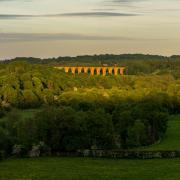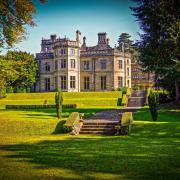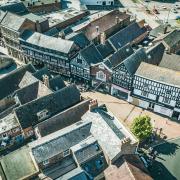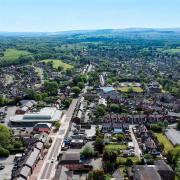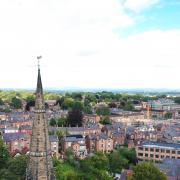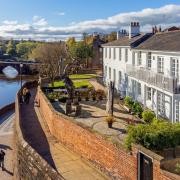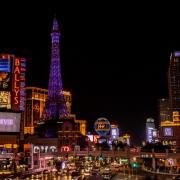Stretching from the foothills of Snowdonia to the Manchester suburbs, the salt marshes at Parkgate to the cloud at Bosley, Cheshire is a county that defies definition – a place steeped in history, a birthplace of industry, and a modern centre of scientific research.

This small market town is one of North West England’s best-kept secrets.
Located close to the Welsh border, Malpas isn’t on a direct road to anywhere. It is approached via a series of country lanes and that could be one of the clues to the town’s enduring appeal according to Bethan Rose-Bailey.
'Malpas is a self-sufficient town with a strong community, a strong town centre and a sense of history,' explains Bethan, general manager of the Lion at Malpas. 'You always get the sense people want to live here and take pride in Malpas.
The Lion is located in the heart of the town. The main building dates back to the 1600s and it contains a remarkable piece of history. King James I, who reigned between 1603 and 1625, stopped off at the house, which became the Red Lion.

'The king entered familiarly into their conversation and enjoyed the hilarity of the evening to which he himself contributed in no small degree.'
King James was unable to keep his identity secret and the chair he had sat in became part of Malpas folklore.
When the Red Lion closed, the chair was sent off to auction, only to be bought back by Malpas residents. To this day, it takes pride of place in the Lion and the names of the owners are displayed next to it.
Woody Barlow, director at locally based Bear Inns, bought the Red Lion in 2020 and undertook a major revamp before reopening it as the Lion at Malpas.
Now a destination pub, it is renowned for its food, and wherever possible uses seasonal local produce.

Malpas is renowned for its excellent schools, including Bishop Heber, a comprehensive high school with a sixth form. Well-known former pupils include auctioneer Christina Trevanion, of Bargain Hunt fame, and England and Sale Sharks Rugby Union players Tom and Ben Curry. The twins’ father, David Curry, is headteacher at Bishop Heber, and coached his sons as young rugby players both at school and at Crewe and Nantwich Rugby Club.
Malpas is also home to Manor House Stables founded by footballing legend Michael Owen, and Donald McCain Racing, which is based at Bank House Farm, Malpas. Donald, known as the North’s leading trainer, took the reins from his father, Ginger, trainer of three-time Grand National winner Red Rum.
No visit to Malpas is complete without taking in the magnificent Grade 1 Listed St Oswald’s Church. The present building dates back to the 14th Century and has strong associations with the Cholmondeley family, of nearby Cholmondeley Castle.
The castle gardens are generally open to visitors on Wednesdays, Thursdays, and Sundays, together with Bank Holiday Mondays, in the spring, summer, and autumn months, although it is advisable to check with the castle gardens website. Nearby, you will find the Cholmondeley Arms pub and Cholmondeley Farm Shop and Café.
Not far from Malpas, on the main Wrexham Road, is the Bickerton Poacher. Famous for its Sunday lunches, it also boasts substantial grounds including a popular camping and motor home field, with full amenities. It sits on the Sandstone Trail, the hiking route stretching 34 miles from Frodsham to Whitchurch.

'It takes a village to raise a child,' an old adage that stands strong says Edward Barnston, Farndon resident and custodian of the Barnston Estate.
The Barnston family have lived and owned land in Farndon for 200 years and currently nurture the magnificent 1,800-acre estate that can trace its history back to around the time of the Norman Conquest.
Edward describes Farndon as a vibrant village with a strong spirit. It is impressively self-sufficient with everything from a newsagents to an award-winning butcher at its centre.
'Farndon has a marvellous mix of cultural and heritage building but its also a place that embraces modern life. There’s a strong sense of community here and an impressive range of businesses on the historic high street,' he says.

Here you will find light industrial units, including a company manufacturing pool tables, together with a gym and a café.
The core activities on the Barnston Estate are farming and forestry but Edward has worked to diversify use to ensure the ancient land holding has a strong future.
Edward’s philosophy is to manage the estate in harmony with the 'triple bottom line' philosophy of balancing People, Planet and Profit – creating value for the local community while being environmentally sustainable and financially viable.
Renewable energy is increasingly important at Barnston. In line with UK and global policy, estate managers are striving to substantially reduce Barnston’s carbon footprint, reducing reliance on traditional fossil fuels. The estate produces its own energy with 100kW of solar energy being generated from the roof panels at Monument Place Business Park, which is offered to tenants at a reduced price.

The Barnston Estate was the first in Cheshire to receive the prestigious Wildlife Farms and Estates Level Two accreditation, the label of excellence in championing the enhancement of wildlife and biodiversity through independent assessment.
Barnston also runs an award-winning natural burial ground in Farndon called the Monument Meadow Natural Burial Ground.
Farndon Bridge is a historic landmark. Originally constructed in 1345, the bridge straddles the River Dee linking Cheshire with North Wales at Holt.

The journey to Crewe from either Malpas or Farndon, takes just half an hour by car, yet the contrast couldn’t be starker. Home to Bentley and a major rail hub, Crewe is, and has been for many years, an engineering town.
It was the railways that built Crewe. The name ‘Creu’ appears in the Domesday book as a small area in the parish of Barthomley; this early settlement was in the area now known as Crewe Green. Development of what is now known as Crewe began as late as 1837, sparked by the opening of the Liverpool to Birmingham railway line by the Grand Junction Railway Company. Six years later, the company relocated its railway work to Crewe and the town grew rapidly. The history of the town can be traced at the Crewe Heritage Centre.
Famously, Crewe is also associated with Britain’s motoring heritage On average, 33 Bentley Continental GTs, 18 Flying Spurs and 33 Bentaygas are built a day at the Pyms Lane site, which has been the home of Bentley since 1946.
Driving towards the town centre from the A500, the main stand at Crewe Alexandra’s stadium dominates the skyline. The Alex play their football in Division Two of the English Football League but these days there’s much more to a football club than 3pm on Saturday afternoons.
The Mornflake Stadium has some of the best event spaces in the area, with the Wrights Lounge catering for parties of up to 350 people.
Morning Foods has been milling oats in South Cheshire for more than 350 years and its Gresty Road base is only a long goal kick from the football stadium that bears the company name.
Business advisor Darren Gallimore of the Federation of Small Businesses, who runs the monthly sponsors' business networking event at the Mornflake Stadium, says: 'I am born and bred in Crewe. If you look at it as a town centre it has had its difficulties, but there’s plenty to recommend the town; it has a strong community.
'As well as Bentley and Morning Foods, businesses include Whitby Morrison, the world's leading ice cream van manufacturer. Crewe now has a strong IT and tech sector, and is home to the Radius fuel card company, which was founded in Cheshire and now operates globally.”
'The market renovation has been popular, and the Lyceum Theatre attracts first-class shows. There are excellent places to eat and drink, such as the White Lion at Weston and Ego at the Fox, Haslington.'

There’s a café, a boating lake, crown green bowling greens, and adjacent to the park you will find the national standard Shanaze Reade BMX track, named after the three times World Champion and Olympian from the town who began racing at the track, then known as Tipkinder Park, as a 10-year-old.
Crewe’s Market is a real gem. Housed in a Grade 2 Listed building, the market was reopened in 2021 following a £3m refurbishment. It’s home to a good selection of independent businesses, offering fresh food, cooked street food and retail goods.
Here you will find everything from Olive’s Cypriot Food to Gumshoe Comics and Collectables. The Cheese Corner is run by Joseph Heler, the long-established cheese maker based at Hatherton, Nantwich.

The most impressive element of the refurbishment is the introduction of The Sheridan Moët & Chandon Champagne and cocktail bar, named after playwright and politician Richard Brinsley Sheridan, a friend of the first Lord Crewe and his wife Frances.
The investment also includes an overhaul of the guest bedrooms in the modern wing.
In the mansion building, extensive updates have been made to the state banqueting rooms, including new carpeting, redecoration of the Old Hall, and meticulous restoration of the beautiful Long Gallery overlooking the back of the hotel.

Middlewich is a town with Roman foundations, dominated by waterways, and provides an answer to a popular quiz question, where is the UK’s shortest canal? The answer is Middlewich, and the canal in question is the Wardle Canal, all 154 ft of it. This tiny waterway links the Trent and Mersey to the Middlewich branch of the Shropshire Union Canal.
Approaching Middlewich, along the A533 from Sandbach, it’s easy to see the canals play a significant role in Middlewich life. They are also a source of tourism bringing regular visitors to the town. This perhaps helps to explain why there are pubs and eateries almost everywhere you look. These include the Big Lock, besides the Trent and Mersey Canal; the White Bear, on Wheelock Street; the Cheshire Cheese on Lewin Street; the Kings Lock, Booths Lane, a real ale and live music pub and the Kinderton, a popular pub, hotel and restaurant recently put up for sale by Shaun Ellison, who says the venue is currently busier than ever and it will be ‘business as usual’ while the Kinderton is on the market.
Family-run Lowe’s Farm Shop in nearby Byley is a gem, selling homegrown vegetables, locally sourced meats, bread and cakes, and a tearoom run by Ginger and Pickles. The Lowe family started selling vegetables from a small stall at their farm before moving to an outbuilding and then establishing a farm shop in 2011. The project has since grown, with the farm shop fully refurbished, and the addition of other businesses in log cabins.
The town centre is home to the impressive Grade 2* Listed St Michael and All Angels Parish Church. There has been a church on the site since the 12th Century, the chancellery and nave date from the 14th Century, and the tower was added in the 15th Century.

Salt gives Middlewich a more modern claim to fame, namely the invention of Bisto gravy. RHM, previously known as Rank Hovis McDougall, was a major employer in the town and Bisto Granules were invented in its Middlewich food laboratory. Its later owners, Premier Foods, closed the Middlewich factory in 2008, but a legacy remains in the shape of the Bisto Kids sculpture.
This famous advertising logo, depicted on the reception wall at the factory, was due to be demolished along with the rest of the building but was saved by the Middlewich Heritage Trust and the town council and relocated to Middlewich’s library.
The town is at the confluence of three rivers, the Dane, the Croco, and the Wheelock.

The influence of heavy industry is clear in Winsford, but there’s beauty at its heart with the Winsford Flashes, a series of three lakes, bringing the countryside into the town centre.
The Flashes cover around 200 acres, and are affectionately known by some as the Cheshire Broads. Although much lesser known than their Norfolk namesakes, the Cheshire Broads were once popular with day-trippers from nearby urban areas such as Liverpool and Stoke-on-Trent. They were never developed for tourism and are now most often appreciated by locals. Winsford Flash Sailing Club offers Royal Yachting Association training courses for all abilities.
The Weaver Way long-distance footpath passes the Flashes. Stretching from Frodsham in the north to Audlem, the route follows the River Weaver and Navigation, as well as the Trent and Mersey, and Shropshire Union Canals.
The Flashes were formed by subsidence most likely caused by brine extraction and filled with water from the River Weaver, a major waterway that both shapes and divides Winsford. The town expanded rapidly in the early part of the 18th Century when improvements to the Weaver made it navigable for sea-going ships from the port of Liverpool to Winsford.

It was often used to transport Cornish clay to Stoke-on-Trent, the home of the pottery industry, and the finished fine china back to Liverpool Docks for export.
While the building of the Trent and Mersey Canal saw the pottery trade on the Weaver slow to a trickle, Winsford soon became an important station on the Grand Junction Railway and to this day the town has good rail links to both Liverpool and Birmingham.
The town centre has the Winsford Cross Shopping Centre, and the Winsford Lifestyle Centre, offering multiple swimming and fitness activities.
Winsford has major links to the salt industry, but the modern-day town has a diverse workforce. It is home to the headquarters of Cheshire Police, has a major office for the Cheshire West and Chester Council and is the location for Cheshire St Luke’s Hospice, opened by the Prince and Princess of Wales, Charles and Diana, in 1988.




